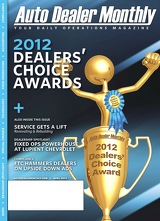Auto Dealer Monthly Magazine is the daily operations publication serving the retail automotive industry. This automotive publication serves dealer principals, officers and general managers with the latest best practices.
Page 25 of 62
industry expert / accounting
I see many dealers who are subletting repairs they could
complete themselves. If you have the shop space, you should be completing these repairs yourself.
The difference between the total hours and the flat-rate hours generated is called unapplied time. The goal is to keep unapplied time to a minimum. Even though the technician may not be busy all the available hours, any differences should be docu- mented on the repair order timecards so you know what they were doing when they had unapplied time. They could have been cleaning the shop or running for parts. If they are actually working but not on vehicles, then their time should be charged to an appropriate expense account and not unapplied time (a cost of sales account with no matching sale account).
Another tip is to not keep repair orders open for long periods of time. Close out the items you have completed and open a new repair order if you are waiting on parts. If you do so, then your sales and cost of sales will be more accurate each month and your internals will update the cost of your inventory much faster.
There is a great possibility of theft in the parts area. To protect yourself, use purchase orders and let your suppliers know they are required. The purchase orders should have the repair order number on them and also a stock number if you are repairing your own vehicle. A random review on a regular basis of purchase
orders and the repair orders they are attached to will hopefully reduce the possibility of theft.
The parts department person- nel should be completing mini parts physicals daily. If you take the number of bins you have in the parts department and divide it by the number of working days in the month, you will arrive at the number of bins you should be taking a physical inventory of daily and verifying the physical counts to the parts pad. You would then run the variance report monthly to see any differences you have encountered. By taking the physicals daily and your entire parts inventory monthly, you hopefully will catch problems before they get out of control. Parts shortages cut directly into your gross profits and should be minimized.
If you structure your parts and service departments to accu- rately track your sales and cost activity with adequate setups of minimum gross profits, you only have to worry about the volume of work you sell. That is up to you.
If anyone would like to receive a spreadsheet to calculate the lost gross profits on internals and the average increase per repair order by charging regular retail rates, please email me and I will send it to you.
23
